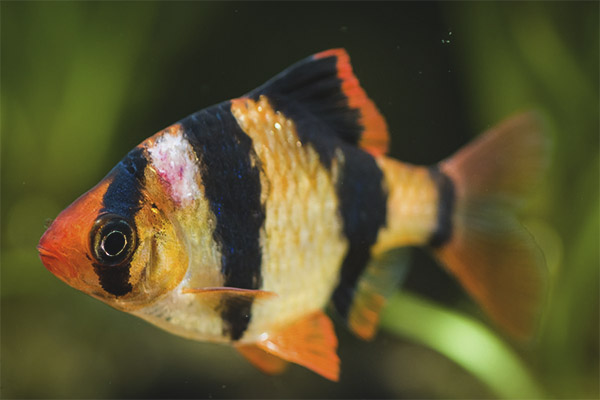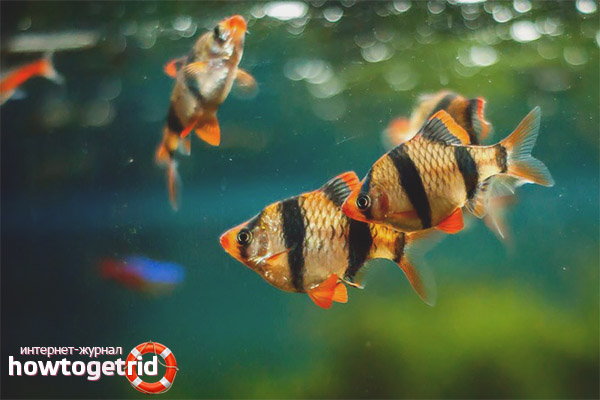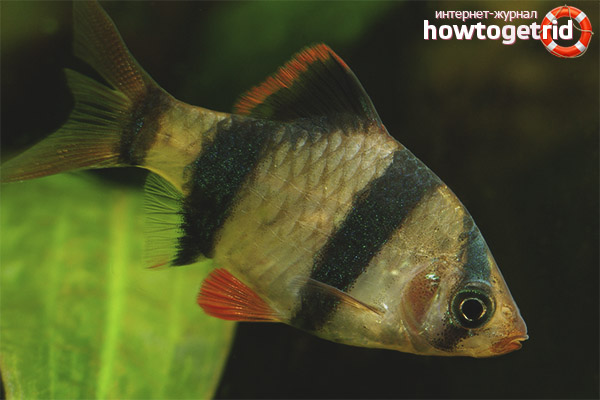The content of the article
If the aquarium lacks an adventurer and a cheerful pet, then we advise you to start a barbus. The fish is distinguished by its beautiful appearance, as well as its unpretentious content. On the basis of the barbat of Sumatran developed many other aquatic inhabitants, differing in color and behavior. But this representative is considered a classic. For many decades, experienced and novice aquarists have kept family members in the reservoir. Today we will analyze everything connected with them.
Description
The first time these fishes were described by Bleker back in 1855. It is believed that the Sumatran representatives then lived in Borneo and Sumatra, because of the second habitat, the breed got its name. Also, fish were found in Thailand and Cambodia. Today this family is so common that it can be found in Australia, Singapore, Colombia and the United States of America.
By their natural features prefer quiet streams, as well as rivers with a small current, which are located in the area of thickets. They love the jungle, because in such places water space is famous for the accumulation of oxygen in large volumes. Fish need sandy soft soil, as well as snags and pebbles as shelters. They feed on insects and larvae in the natural range, as well as detritus and vegetation.
As for the external data, the hull of the fish is compressed from the side parts. The head is rounded, pets grow up to 7 cm in height, but this is rare. In the aquarium environment, their length hardly exceeds 5 cm. It all depends on the type of tank, food, and other conditions of detention.
In terms of shade, the specimens are yellowish, reddish, or faded brown. A characteristic feature are the stripes of dark tone going through the body. When the fish season begins, the bands become reddish.
It is difficult to determine for sure which sex an individual belongs to if it has not yet reached puberty. When spawning begins, the female individuals are rounded in the abdominal part, and the male fish acquire a rich coloring. Males are smaller, their head is more red.
If you keep these aquatic guests in the aquarium environment, they will live up to 4 years and will delight the owner. But fish are prone to overeating and do not know the sense of proportion, therefore, they often die of gluttony. The future owner should know when and in what quantities to feed the fish.
Content
- Fish are quite active, so special attention is paid to the choice of a reservoir for their maintenance. Barbs do not belong to the types of pets that swim or in the valley, or at the top. They feel well in all layers of water space. Choose an elongated reservoir so that the fish grow well and quickly.
- Take care of shelters, which can act as snags, cobblestones without sharp edges, various pipes, grottoes, clay pots. Plant the side parts of the aquarium with vegetation, and leave the middle section for swimming.
- If the fish of this family are kept alone with other groups, it will be extremely aggressive. Therefore, immediately buy and start a flock of barbs to partially reduce their anger towards others. Buy from 10 or more individuals.
- Special attention is paid to the temperature environment. So, for example, fish love moderate heat, so it’s best to keep them at 23-26 degrees. The water should be perfectly clean and soft; purchase a filter in advance. But he must not create a current.
- As for coverage, the family members have no requirements for this aspect. You can restrict a single lamp with a diffusing light mounted on top or from the side. The fish are bouncy, so the upper section is covered with a lid, and the water surface is lined with floating plants.
- Take care of aeration by installing the appropriate device. Since in the natural environment fish live in water with a large amount of oxygen, this must be ensured in the aquarium. Also replace a third of the water weekly to always be clean.
- Do not worry if you see that the fish fall downside down, and their body is located vertically. Barbus so rest or sleep, moving away from the hustle and bustle around.
- To make the pets of this breed feel comfortable, they are not planted with large and aggressive fish. Choose active guests who will not interfere with their slowness barbs amuse themselves.
Feeding
- Beginners choose this type of fish due to the fact that it is unpretentious in terms of diet. He eats almost everything that gives the owner. Loves dry food developed specifically for these fish.
- It is also allowed to treat pets with frozen and live moths, pipe makers, sponge and daphnia.
- To saturate the diet and prevent spoilage of vegetation, fish are sometimes given cucumbers, zucchini, boiled greens and food with spirulina.
- Since individuals of this group are prone to overeating and die of gluttony, they are fed twice a day. Food should be so much that the fish ate it in 1-1,5 minutes.
Compatibility
- The considered barbs are related to schooling individuals. Therefore, it is strongly recommended to start at least 7 small fish of the same species. Often, these inhabitants of the aquarium show aggression to many fish. If the flock is small, the barbs will begin to tear off the fins to other individuals.
- If the family of barbs is relatively large, then aggression towards the neighbors is significantly reduced. Individuals of the same species are engaged with each other. Still, you should not start slow and calm fish together with the barbs. Among them should be distinguished liliius, cockerels, marble and pearl gouras, goldfish and scalar.
- The considered individuals get along well with fast inhabitants.These are ternation, zebrafish, congo, speckled catfish, diamond tetras and taracatums.
Breeding
- If you are going to get fish for the first time, then barbeses will be ideal for you as feces. At the same time, it is strongly recommended to feed the fish with various feeds. Try to diversify the diet. Let's not only dry, but also live poop. As a result, the barbs themselves will show a desire to spawn.
- These individuals reach sexual maturity at 6 months. In this case, it is not at all necessary to seat the males and females in different capacities in order to prepare them for spawning. But in order to avoid any problems, it is better to set up individuals so that females can feel more comfortable.
- Water temperature in the habitat should be about 23 degrees. In order for females to develop in females without any problems, the fish should be fed with various feeds. It is also worth focusing on a live product. Barbusses excellent eat koretra, pipe maker and bloodworms.
- Be sure to prepare a spawning ground in advance. Capacity should be at least 15 liters. In this case, the soil does not necessarily put.The only thing that should be noted in the aquarium is to install a separation net. Thus, parents will not eat caviar.
- Also in the breeding ground is not recommended to run and snails. Synthetic fibers or Java moss should be used as a substrate. Put future parents in the spawning evening. Raise the temperature of the medium to 25 degrees. Feeding individuals is not necessary.
- As the sun rises, the individuals begin to spawn. Spawning time is several hours. Often the female brings up to 600 eggs at a time. After that, individuals should be transplanted into the general aquarium. In the breeding ground, it is recommended to replace part of the water with fresh one.
- Also in the breeding ground is recommended to add methylene blue. Water should get a bluish tint. A similar procedure is carried out to ensure that the fungus does not begin to develop on the eggs. For some time, spawning is recommended to darken. Sunlight should not fall into it.
Barbusses do not require special conditions of detention, they are not picky in terms of basic nutrition. But take care of a sufficiently spacious tank, leave room for swimming.Observe the temperature regime of the aquatic environment, maintain aeration at the proper mark, regularly make water changes.
Video: aquarium fish barb Sumatran













To send